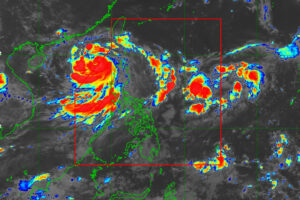
15 dead as Severe Tropical Storm Yagi leaves Philippines
A SEVERE tropical storm that killed at least 15 Filipinos left the country’s area of responsibility on Wednesday morning, but classes and government work across the country remained suspended amid an enhanced monsoon that was expected to bring heavy rains within the week.
Severe Tropical Storm Yagi, centered about 265 km west of northwest of Laoag City at 5 a.m., was already outside the Philippine Area of Responsibility (PAR), state weather bureau Pagasa (Philippine Atmospheric, Geophysical and Astronomical Services Administration) said in a morning report.
Still, the enhanced monsoon will bring moderate to intense rainfall in the next three days, especially in the western parts of Luzon, it said.
The bureau said later in the day that Yagi, locally known as Enteng, was moving generally westward.
The death toll from Yagi, which battered five Luzon regions as well as central and eastern Visayas, had risen to 15.
The deadliest province for Yagi was Rizal — east of the capital Manila — where authorities logged eight deaths due to drowning and landslide, Office of Civil Defense Operations Service Director Cesar Idio told President Ferdinand R. Marcos, Jr. in a situation briefing on Wednesday.
In central Philippines, Cebu City and Northern Samar logged two deaths each while Negros Occidental recorded one fatality, he said. Naga City in Bicol region recorded two deaths, he added.
Twenty-one people were reported missing while 15 others were injured, Mr. Idio said.
“These are still subject for validation.”
The OCD said about 1.72 million people or 442,804 families were affected by Yagi, adding that the Bicol region was the most affected area, followed by Central Luzon, Eastern Visayas, and Metro Manila.
The storm caused P350.85 million worth of damage in agriculture, with 13,623 farmers affected. Production losses hit 14.814 metric tons in 8,893 hectares of agricultural land involving rice, corn and high-value crops.
A 6 a.m. report by the Department of Public Works and Highways (DPWH) showed that the storm and an enhanced southwest monsoon left an initial P54.26 million worth of damage to infrastructure.
It said damaged roads, bridges, and flood control structures were reported in the Cordillera, Central Visayas and Eastern Visayas.
Central Visayas incurred the most damage with P25.78 million, followed by Eastern Visayas with P23.64 million, and Cordillera with P4.8 million.
OCD said about P33 million worth of food and non-food items have been distributed to affected people.
P23-BILLION AGRI-DAMAGE
In a separate briefing, the Agriculture department said the damage due to El Niño coupled with recent weather disturbances was estimated at P23.19 billion.
“These are due to the combined effects of El Niño, shearline, southwest monsoon, Typhoon Aghon, Typhoon Carina, and the (Severe Tropical Depression) Enteng,” Agriculture Assistant Secretary Arnel V. de Mesa said in a media briefing. A
According to data from the Agriculture department, the total volume loss for crops was estimated at 964,310 metric tons (MT), to date.
The weather events had affected 558,174 farmers and fisherfolks, with total affected area spanning 408,479 hectares of farmland.
He added that rice crops bore the brunt of the impact from the recent weather disturbances with total volume loss reckoned at 373,000 MT.
“This is already close to the annual average of 500,000 MT to 600,000 MT in losses for rice,” Mr. De Mesa said. Total estimated damage for rice crops was at P8.13 billion.
He added that the incoming La Niña could still pose a threat to local rice production amid the increase likelihood of storms.
According to the state weather bureau, PAGASA the incoming La Niña could form in the next three months with a 66% likelihood between the months of September to October.
PAGASA said that about eight to 14 tropical cyclones are forecast to enter the Philippine Area of Responsibility until January 2025.
“This all depends on when the peak of La Niña will be felt. But, if you look at the current trend of typhoons, the amount of water they bring is huge,” Mr. De Mesa said. — Kyle Aristophere T. Atienza and Adrian H. Halili



